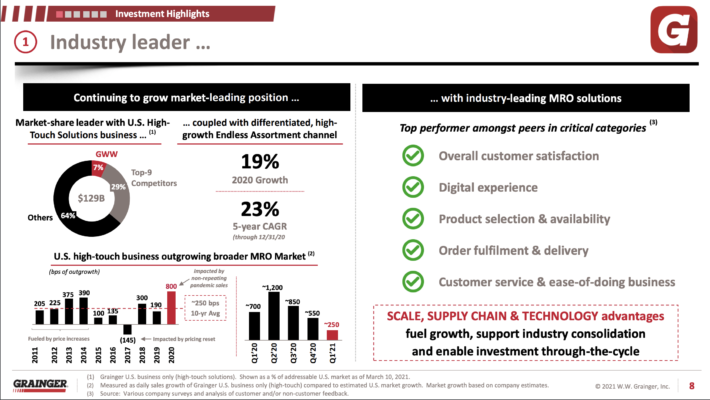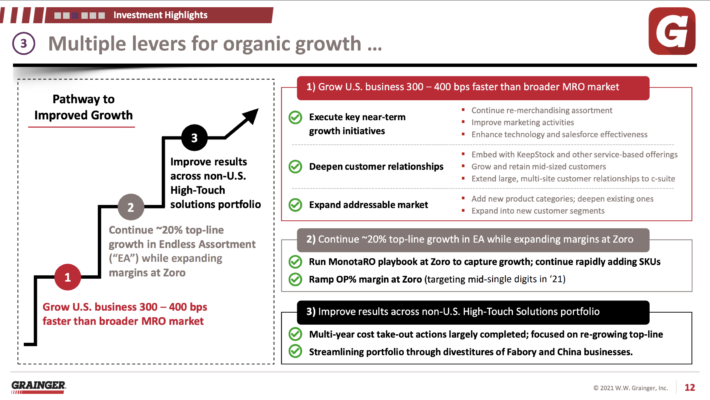Dividend Kings In Focus: W.W. Grainger
W.W. Grainger, Inc. (GWW) recently increased its dividend for the 50th consecutive year. As a result, it has joined the exclusive list of Dividend Kings.
GWW has maintained its long history of dividend increases thanks to a superior position in its industry. Its competitive advantages have fueled the Company’s long-term growth.
As we see continued growth in the business-to-business distributors of the maintenance, repair, and operations (“MRO”) supplies industry, GWW should keep increasing its dividend each year.
This article will discuss GWW’s business model, growth catalysts, and expected returns.
Business Overview
W.W. Grainger, headquartered in Lake Forest, IL, is one of the world’s largest business-to-business distributors of maintenance, repair, and operations (“MRO”) supplies.
The company was founded in 1927 and generated sales of nearly $12 billion in 2020. Grainger trades with a market capitalization of $26 billion.
Grainger is a member of the Dividend Aristocrats Index as well as the Dividend Kings.
GWW has about 5 million active customers, with nearly 26 million products offered globally.

Source: Investor Presentation
On October 29, 2021, the company reported its third-quarter and nine month results for Fiscal Year (FY) 2021. Quarterly revenue equaled $3.37 billion, an 11.8% increase compared to Q3 2020.
Sales growth was driven by both the High-Touch and Endless Assortment segments. For the nine months of the fiscal year, revenues increased 9.1%.
Operating earnings were up year-over-year for the quarter and the nine months, by 15.2% and 51.9%, respectively. Operating earnings growth was propelled by an increase in operating margin of 13.0%, up 45 basis points on a reported basis, and up 65 basis points on an adjusted basis.
Adjusted net income equaled $297 million or $5.65 per share for the third quarter compared to $246 million or $4.52 per share in the same year-ago period.
However, for the first nine months, adjusted net income equaled $760 million or $14.40 per share versus $527 million or $9.70 per share, which is an increase of 48.5% year-over-year.
On the quarterly report, the company reaffirmed its guidance ranges previously provided for 2021. Given the solid results of the third quarter, GWW’s management team expects revenue to finish the year near the midpoint of $12.7 – $13.0 billion.
On an earnings basis, GWW’s management team expects that the company will earn between $19.00 – $20.50 per share for the full year of 2021. Thus, we will use the midpoint of $19.75 per share for our fair value and total return calculations.
At $19.75 per share, this would represent an increase of 22.1% compared to FY 2020, when the company earned $16.18 per share.
Growth Prospects
Grainger has grown its earnings-per-share at a 6.7% average annual compound rate between 2011 and 2020. This result was driven by 4.3% yearly revenue growth, an expanding profit margin, and a share count reduced by an average of -2.9% per year.
Earnings dropped slightly due to the impact of the COVID–19 pandemic in 2020. For example, in 2019, the company earned $17.29 compared with $16.18 per share for FY2020, which was a decrease of 6.4%. However, there has been strong demand for the company’s products in 2021.
Combined with higher prices caused by supply chain issues, and these factors should bring a higher rate of growth for the company.

Source: Investor Presentation
The above image shows us how Grainger will continue to expand organic growth. For example, the company plans to deepen customer relationships through service-based offerings, which should help increase same customer sales, and total revenue.
In addition, GWW is expanding its addressable market with new products and new customer segments.
For the third quarter of FY 2021, Grainger returned $327 million to shareholders through dividends and share repurchases. This will continue to help drive earnings growth, as the company has decreased share count by 2.7% per share since 2011.
Overall, we expect GWW to grow earnings-per-share by 5% per year over the next five years.
Competitive Advantages & Recession Performance
Grainger’s most significant competitive advantage is that the company is an industry leader in MRO products. We believe that the company has a solid ability to fight off pressures from new (i.e., Amazon) and existing businesses in the MRO market.
This exclusivity is built by solid supplier relationships. Because Grainger is the largest MRO industrial distributor in North America, the company benefits from volume-based discounts and other sales incentives that would be unattainable to smaller distributors.
These competitive advantages provide the company with consistent growth, even during economic downturns. Grainger grew earnings during the Great Recession.
Grainger’s earnings-per-share during the recession are as follows:
- 2007 adjusted earnings-per-share: $4.94
- 2008 adjusted earnings-per-share: $6.04 (22% increase)
- 2009 adjusted earnings-per-share: $5.25 (13% decline)
- 2010 adjusted earnings-per-share: $6.80 (30% increase)
This growth during the Great Recession speaks volumes on the resilience of the company. As mentioned above, the company performed well during the COVID-19 pandemic, with only a 6% earnings decline in 2020.
Overall, the company sports an A+ credit rating from S&P with a debt to equity ratio of 1.3, which is very solid. Thus, Grainger has the balance sheet strength to withstand another recession.
Valuation & Expected Returns
We expect GWW to earn $19.75 per share this year. As a result, the stock is currently trading at a price-to-earnings ratio of 26.1.
Over the past decade, shares of Grainger have traded with an average P/E ratio of 19 times earnings. We are using 18 times earnings as a fair value baseline, considering a slightly slower expected growth rate.
As a result, we view the stock as overvalued right now.
If the P/E multiple declines from 26.1 to 18.0 over the next five years, shareholder returns would be reduced by 7% per year.
However, dividends and earnings-per-share growth will boost shareholder returns. GWW shares currently yield 1.3%. And, we expect 5% annual EPS growth over the next five years.
Putting it all together, GWW stock is expected to generate negative annual returns of 0.7% over the next five years. This shows the significant impact that over-valuation can have on a stock’s future expected returns.
Final Thoughts
Grainger is a solid company with a tremendous earnings and dividend growth history. It is now a new member of the Dividend King list, which has increased its dividend for more than 50 consecutive years.
However, the shares are trading at high valuations compared to our fair value estimate. As a result, total return potential comes in at a negative 0.7% per year over the next five years.
Even though the total return proposition does not appear compelling, the resilience of the company, its low dividend payout ratio and impressive dividend growth streak are notable. Still, shares earn a sell rating at the current price.
Disclaimer: Sure Dividend is published as an information service. It includes opinions as to buying, selling and holding various stocks and other securities. However, the publishers of Sure ...
more


